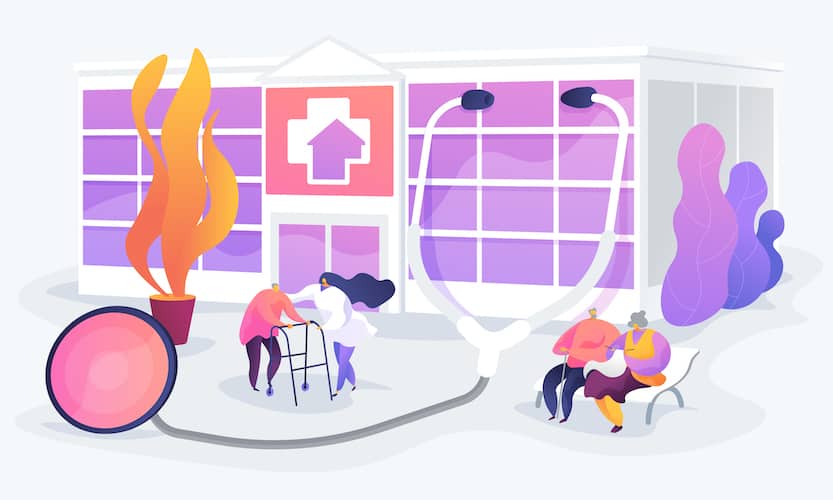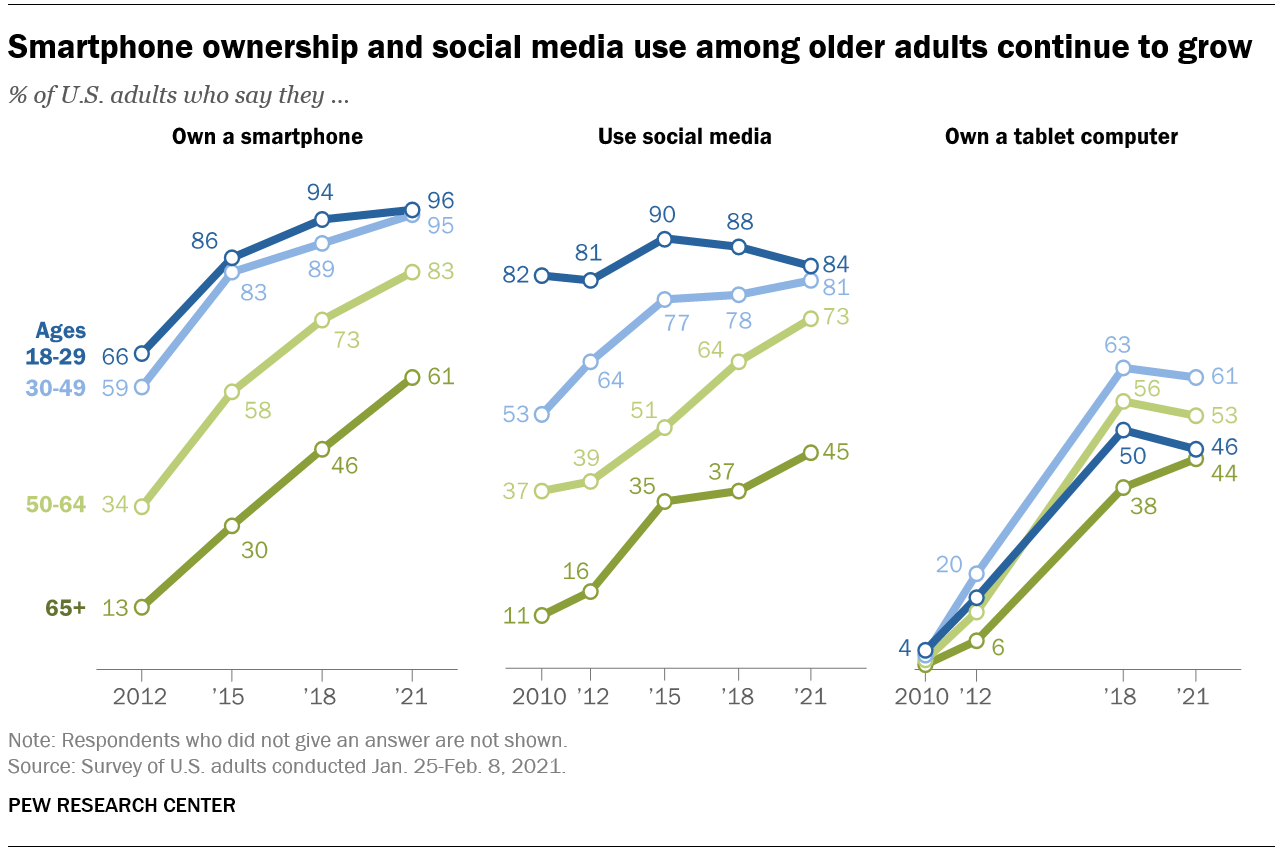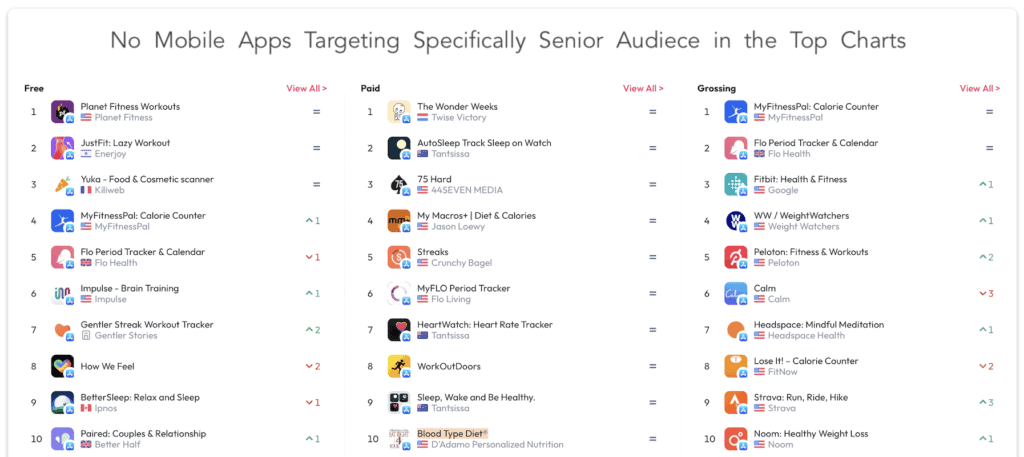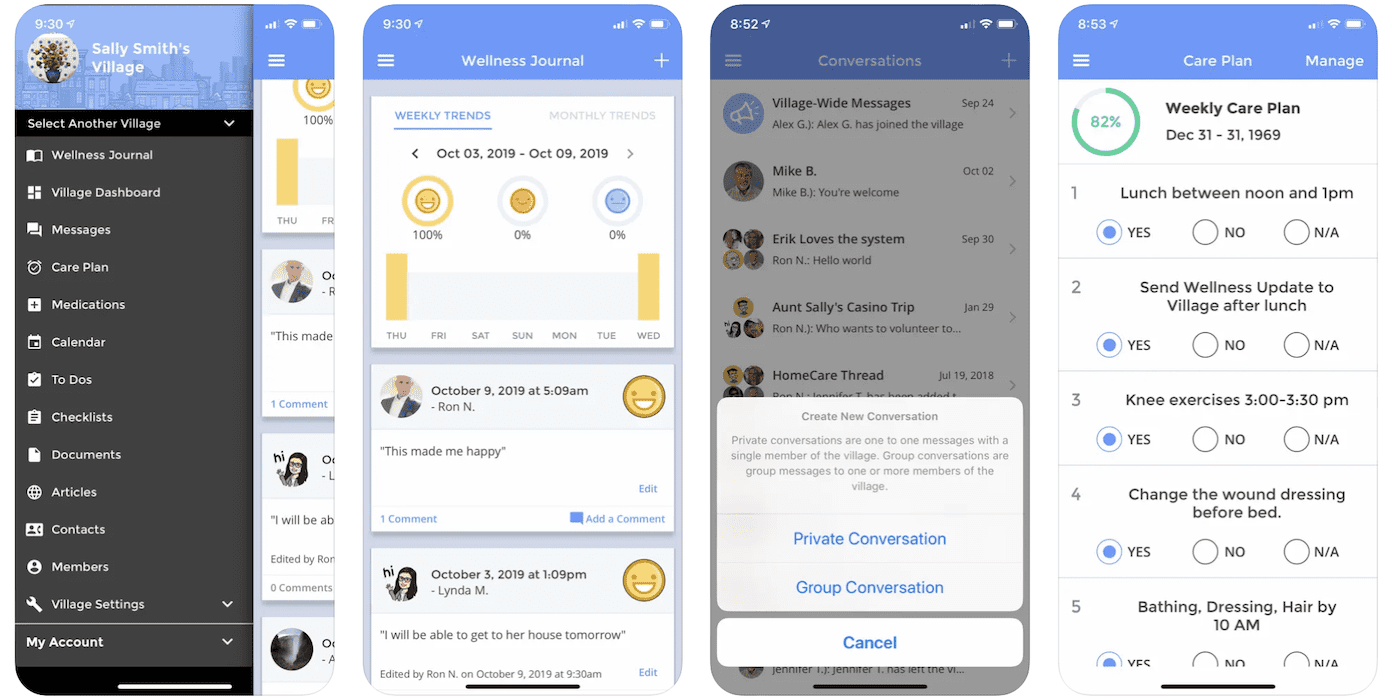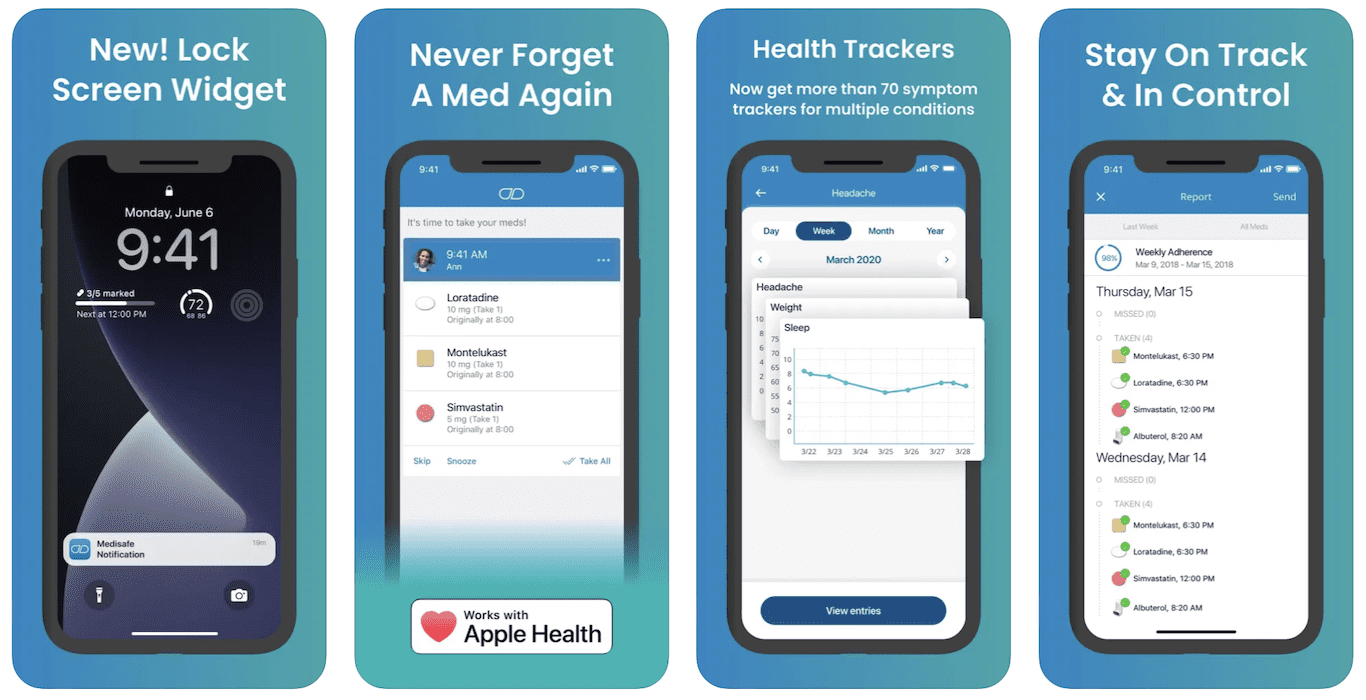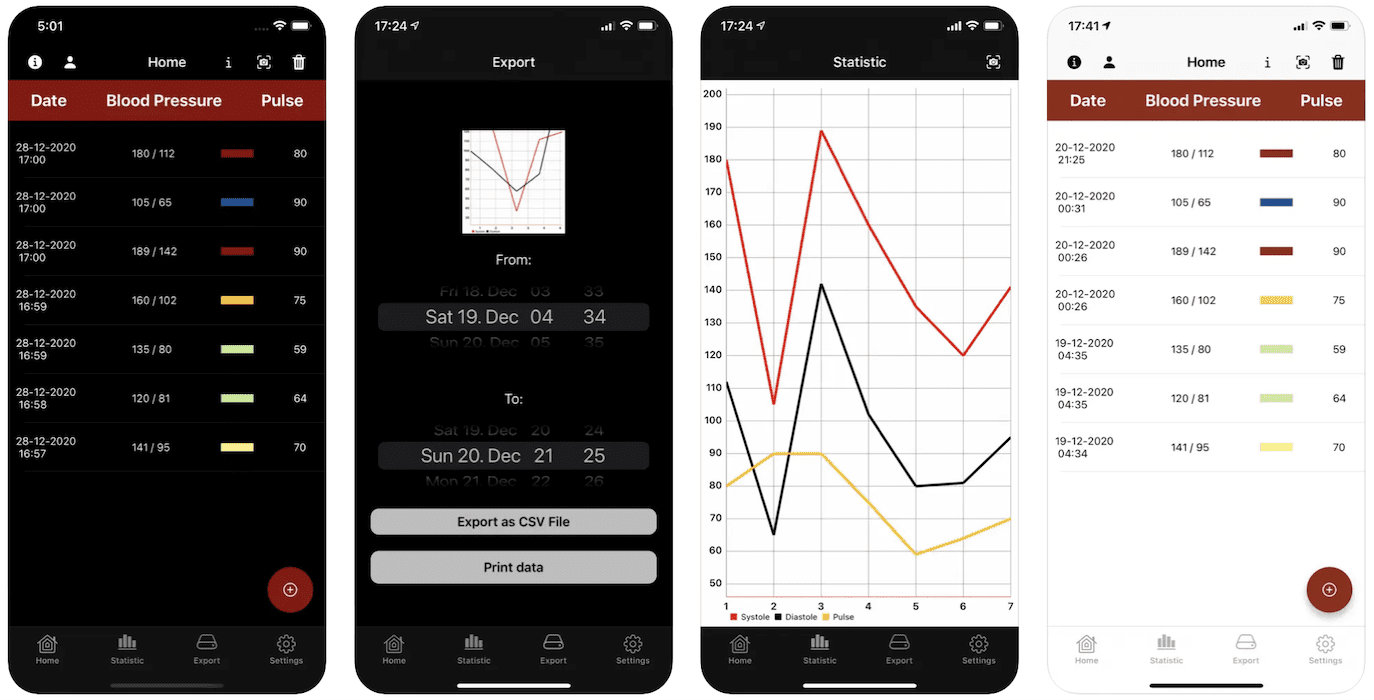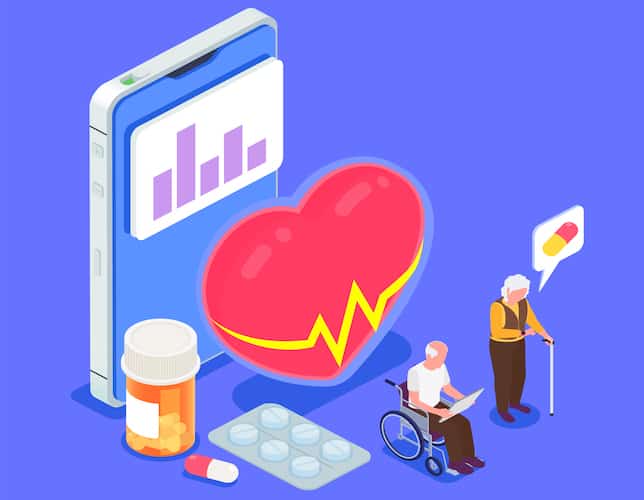The tech progress has come for elders. When everyone around is on a phone getting all sorts of things done, you’re likely to catch the same mobile bug.
What’s top of mind for many older people? It’s their health, right? So, no wonder senior care app development has become a hot topic among healthcare-focused entrepreneurs looking to empower elderly patients. It’s right there with femtech and wearables.
If you want to make a successful senior care app, now is the best time. Let’s discuss the best way to approach this challenging task.
Key Takeaways:
- Surveys show that smartphones have become ubiquitous among senior people. Yet, only a fraction of them use healthcare apps; and not because it’s technically challenging.
- A quick answer to “How to develop a senior care mobile app that makes a difference” is “Focus on the ease of use and accessibility and make use of RPM technologies”.
- Elderly care app development implies creating an application for patients, a standalone application for providers, and a web portal for management. Even if you only build an on-demand elderly care service app, you must create a web panel to manage this software.
Table of Contents:
- Senior Care App Market Overview
- Why Develop a Senior Care Mobile App?
- Types of Senior Care Apps
- 9 Things to Consider before Starting Elderly Health Care App Development
- Features of an Elderly Care App
- Steps of Senior Care App Development
- How Much Does It Cost to Build an On-demand Elderly Care Service App?
- Topflight Experience in Developing Senior Care Apps
Senior Care App Market Overview
The aging US population (73 million adults will turn 65 and older by 2030) and the skyrocketing cost of elder care, coupled with the shortage of qualified medical personnel, literally beg for a technological resolution. Here are a few stats to back the need:
- 10,000 baby boomers turn 65 every day until 2030
- elderly & disabled services US market size in 2022 is $60 billion
- seven out of every ten people will require long-term care
- the annual cost of long-term care ranges from $60K to $108K (lower on the home care end)
- the US home care market is expected to grow to $225 billion by 2024
- by 2025, US elder care will face a shortage of 500,000 home health aides, 100,000 nursing assistants, and 29,000 nurse practitioners
- 87% of seniors want to receive care in their current home and community
Fortunately, seniors are getting better and better at leveraging modern technologies. According to Pew Research Center, well over 50% of older adults own a smartphone or a tablet:
Yet, it’s not like you’re going to compete in an overcrowded marketplace of elder care applications. The University of Michigan National Poll on Healthy Aging states that only 21% of adults aged 50-80 use at least one health mobile app, 16% have stopped using such software, and 56% have never used a healthcare app.
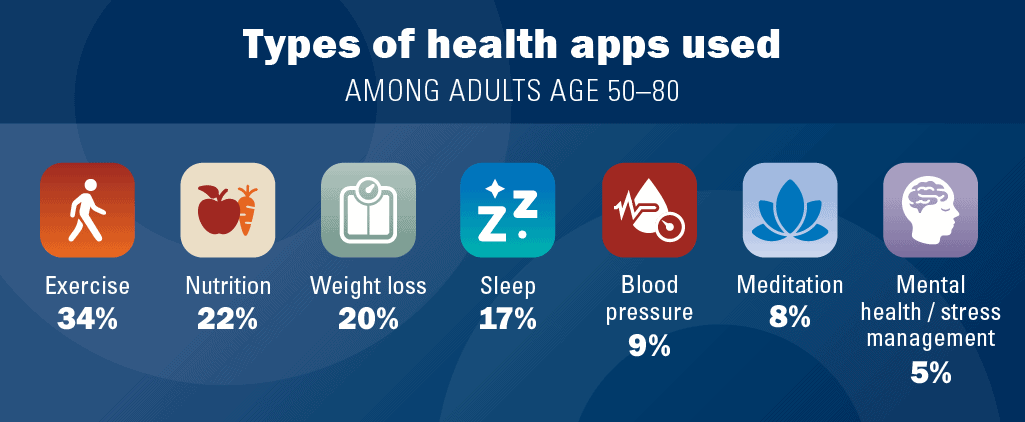
It’s also interesting to note how seniors who took part in that survey justified not using healthcare apps:
- 51% lack interest in health apps
- 32% never thought about using such applications
- only 14% were uncomfortable with technology
To me, that literally screams that the majority of older people are at the mercy of providers acknowledging the value of technological solutions and introducing them into their care practices. All of that must bring elderly healthcare app development into boardrooms looking for new optimal business models.
One last thing worth reiterating here is that you won’t face too much competition in the elderly care applications field. There are no healthcare apps targeting older adults in the top 100 mobile healthcare applications.
Try looking for “senior care” in the App Store or Google Play. You’ll be pleasantly surprised because the competition is simply not there. Patients are fortunate to occasionally stumble into such software only if their providers offer these services (using the web or mobile technologies).
Image credit: data.ai
Why Develop a Senior Care Mobile App?
As already mentioned, the accessibility of technology and the growing market make mobile and web applications solid contenders in pushing senior care forward. Here’s how aged care app development helps the geriatric care space to progress:
- improving care accessibility
Being able to send health data from the comfort of one’s home or receive home care significantly lowers overall healthcare expenditure on both sides.
- enabling remote care models
Doctors can finally get an accurate picture of patients’ everyday lives and provide timely assistance and preventive measures.
- increasing the quality of delivered care
As a result, seniors get genuinely patient-focused care (and these are not abstract senior citizens we’re talking about here because doctors deal with a particular patient’s health data, which becomes available remotely)
- democratization of care through removing intermediaries
There are still many regulatory hurdles that healthcare organizations must overcome. Yet, senior care applications can absolutely achieve results comparable to what Uber did to the taxi industry.
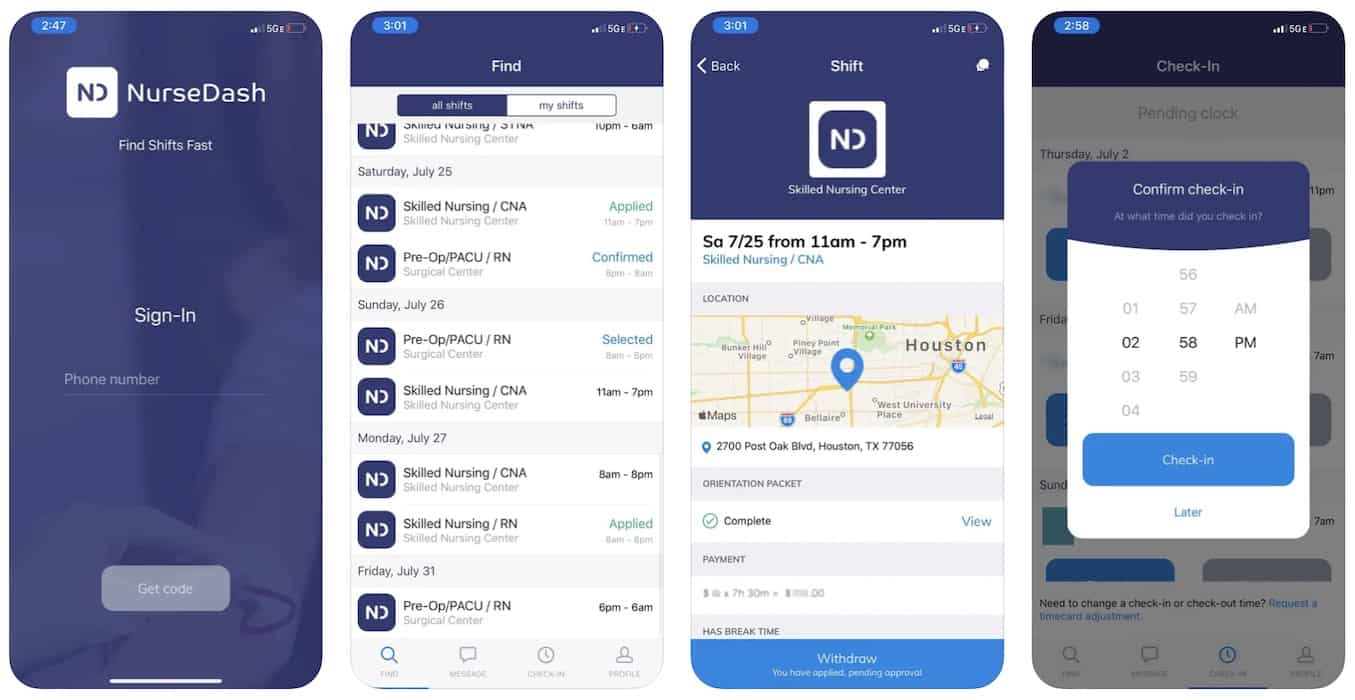
- attracting more qualified personnel on the provider’s side
This one may seem counterintuitive because healthcare apps don’t come with staff built-in, do they? The shortage of qualified medical personnel is still a shortage.
However, applications help improve efficiency by using location services and other automation, including smart AI algorithms that match caregivers to patients for optimal care quality and delivery.
Types of Senior Care Apps
Let’s quickly discuss what types of elderly care apps you can build, shall we? Two main variations of such software have already gone mainstream in the healthcare industry. You can build an app for elder care that’s focused on the following:
- telemedicine and
- remote patient monitoring (RPM)
Partially, such software becomes mandatory because of regulations. Come January 2023, electronic visit verification (EVV) becomes compulsory for all Medicare-reimbursed home health care providers. Then the recent pandemic took its toll as occupancy at independent living, assisted living, and nursing care facilities plummeted from over 90% to 75-80%.
But before we go any further, what if I tell you that the best mobile app for a retired person is no app at all? What if there’s software that empowers doctors, aides, and patients but requires no patient app at all?
Topflight was fortunate enough to help bring into reality such a vision for one of our partners, Dedica Health. This cardiology practice uses clinically certified medical sensors to collect health data from patients and charts it for doctors in a web app. There’s much more for doctors to do in the app, but first and foremost, they can communicate with patients from the web app. And for patients, this looks like texting.
I’d like you to note two things here:
- a mobile app can be replaced with a smart health sensor
- RPM and telemedicine can still happen without a dedicated mobile app for patients
Of course, a web or mobile app can offer even more value to patients when paired with a sensor. However, a zero-app approach is still something to think about when you’re looking to introduce an elegant (yet, tech-heavy) solution for people who’d take any excuse to shy away from a phone.
Anyways, what other types of elderly care software can we build? Based on a feature set, these can be:
- fitness applications
- software for training cognitive functions
- lifestyle (nutrition, sleep tracking, etc.)
- create an on-demand app (à la healthcare services marketplaces)
- e-prescription and pill-tracking solutions
- blood-pressure tracking software
- mental health applications
- fall prevention mobile software
- dementia tracking applications
Of course, based on your goals, you can mix and match different features within one and the same application, or you can even choose to combine all of these features to build a super app if that justifies the holistic care model at your medical facility.
Finally, we can differentiate elderly care software based on the target audience:
- patients
- community or family members (why is there no marketplace for volunteers to sign up as caregivers providing basic non-licensed home care services?)
- doctors, nurses (nursing care apps), and other caregivers
Image credit: App Store, Caring Village
Creating elderly care apps requires the support of a custom mobile application design and development team to meet specific user needs.
9 Things to Consider before Starting Elderly Health Care App Development
Before we discuss the practical steps of elderly caregiving app development, let’s zero in on what makes elderly software stand out and what you should foresee when building it. Here are a few things our healthcare app development company discovered:
Accessibility
Accessibility is the first thing that comes to mind, right? Making fonts larger, increasing contrast ratio, reducing motion effects, and supporting voice-over features built into iOS and Android — these and other accessibility options will make your mobile software easier to use for elderly people.
Intuitive UX/UI
The software design should be super easy to use: the fewer taps on each screen, the better; the bigger tap areas, the better.
Also Read: 7 UX/UI Design Tips and Health App Design Guide.
I dare say we should go out of our way and dumb-down interfaces in senior care apps. Not because seniors are dumb but because they probably less few applications overall and are not used to UX tricks that tend to change over time. We may have to break down trending UX best practices to accommodate the flows that feel logical to seniors.
Image credit: App Store, Medisafe
Contextual help
In line with the previous point, contextual help implies using visual and voice clues, helpful tips, and mini-tutorials to explain how the app functions. As the user grows accustomed to different features, they may want to turn off the contextual help option in the settings.
Support for older phone models
If we find out that our target audience is still comfortable with older phone models, we must ensure that the software works on these models and respects the UX/UI patterns dominant on these phones. Android even launched the Android One initiative simplifying app developers’ work supporting older Android OS versions.
Extra focus on edge cases
What happens when the application goes offline? Do we provide enough relevant info for the user? What if they run into some error? Seniors may shy away from apps that display confusing error messages or turn unresponsive. Therefore, extra careful testing for edge cases is a must.
Voice control
Older people may prefer to use voice commands to work with the senior care software. However, that will only work if we provide enough info on how that works precisely. Integration with Google Assistant, Siri, or other voice APIs specific to the platform will be required.
Image credit: App Store, Blood Pressure Diary
Target platform
Do we want a dedicated smartwatch app that takes advantage of advanced sensors for health data harvesting (e.g., fall detection or ECG)? Will our fitness application perform better on Apple or Chrome TV? Utilizing unique platform capabilities is critical to creating an engaging, welcoming user experience for older adults.
Human support
Some say, “Give ‘em chatbots!” I say don’t. An AI chatbot helping answer the customer’s questions is a decent fallback option when a human is unavailable. Otherwise, having a good old tap-to-call button or a live chat with support staff will help you establish this much-needed trust.
Consistent user experience
Modern apps integrate with each other pretty well: maps, contacts, weather, etc. — you can link virtually to any other mobile software from your senior app (if that makes sense). Despite that, I suggest you handle as much third-party functionality as possible inside your elderly care app.
For example, if you show navigation to a medical facility, do it right inside the app instead of throwing the user into Google Maps or Apple Maps. The fewer interruptions customers experience, the more engaged they’ll remain.
Features of an Elderly Care App
No one but you know better what to include in a senior app. After all, you’re just trying to simplify and automate certain routines by using mobile technologies:
- location-awareness
- speech recognition and built-in AI assistants (reachable via APIs)
- notifications and reminders
- accelerometer and other smart sensors (from fall detection to sound volume measurement)
- AI and ML (not necessarily mobile tech, but very viable on phones and tablets)
- augmented reality (for example, exercising with a virtual coach)
- virtual reality (if you want to be a trendsetter; think mental health)
- BLE medical IoT integrations (for harvesting and syncing health data)
- mobile payments
If I’m candid, these technologies are just the tip of the iceberg of what’s possible with mobile/web features in senior care applications. However, we should always focus on what makes sense for providers and patients and build our feature set accordingly. In other words, tech comes second after the customer’s needs.
5 Steps of Senior Care App Development
If you think about it, a senior care app fits perfectly with the different types of healthcare apps we discussed in our previous blogs.
The only difference is they target elders and need to account for their specific needs. At the same time, the routine of elderly health care app development remains the same:
- Step #1: discovery (we kick it off with Pre-flight Workshop)
- Step #2: prototyping (creating and validating an app simulation)
- Step #3: development of a proof of concept (critical features deliverable within three months)
- Step #4: iterating on the PoC until we have an MVP to release (Minimal Viable Product is meant for the general public)
- Step #5: maintenance (gathering stats on user engagement and app performance to guide further elder health care app development)
There’s a lot to share about each of these steps. For instance, we may focus on AI algorithms validation or low-code/no-code development during the PoC step, depending on the type of elderly app we’re building.
You can find more details in the previous blogs about e-prescription, fitness, yoga, mental health, chatbot, skincare, telehealth, pharma, meditation, on-demand physiotherapy, pill reminder, appointments, nutrition, women’s health, RPM, and IoT.
As long as you build applications for senior care, the software will likely meet one of these app profiles.
Related: How to Build an On-Demand Pediatric App
How Much Does It Cost to Build an On-demand Elderly Care Service App?
If you want to develop an elderly health care service mobile app, be prepared to budget between $80,000 and $160,000, depending on the type of software. However, with a no-code approach, which can be very useful for piloting a senior care app idea, you can get started at $40,000.
We cover the typical healthcare app development cost in our FAQ if you want to check that too. Here’s an excerpt:
Firstly, we do not provide total project estimates. We created Topflight to be a software development experience that’s more like a top VC-funded startup team at a fraction of the cost. We are not hired guns to ship a cheap MVP, then bail.
This is how we work with our clients:
- Start with Rapid Prototyping to validate Product-Market Fit.
Rapid Prototype Full if you have no design assets ($15,000 – $20,000)
Rapid Prototype Lite if you already have some UX design assets ($10,000 – $12,000)
- Code and Launch a 3-month Proof of Concept ($80,000 – $90,000)
- Keep building in Agile sprints of 30 or 60 hrs per week ($15,000/mo or $30,000/mo). This covers getting from Proof of Concept to the Minimal Viable Product (MVP) and continuous product iteration until we hit the desired traction.
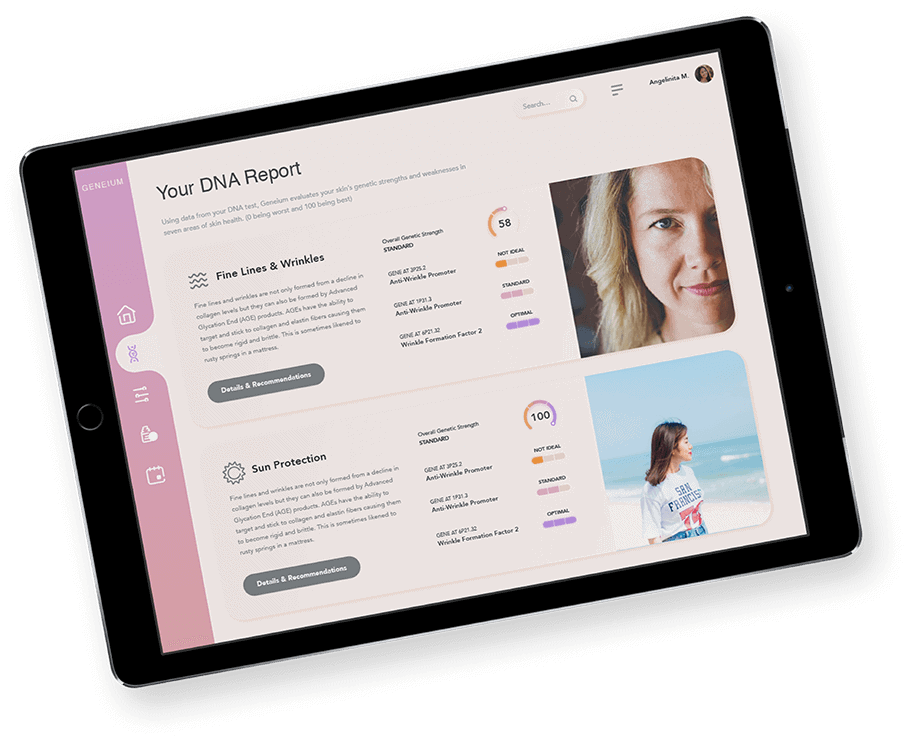
This is what you get when you work with us:
– Beautiful, validated UI/UX design that users love
– Product strategy to keep users engaged over time
– Project management for total transparency into progress
– Full-stack development for web, mobile, IoT, web3
– Machine learning development
– Devops engineering to automate all repetitive dev activities, make the application hum and scale
with infrastructure, add fort knox security.
– QA test automation to save developers and manual testers time
– App marketing and sales development to affordably acquire new users
Building a team like this from scratch takes a 7-figure payroll. Our swiss army knife approach, where we give you what you need precisely when you need it, delivers this at an annual cost of around 25% of that.
Topflight Experience in Developing Senior Care Apps
There are a few mobile applications we worked on that fit the senior care app profile. Two recent ones that come to mind are a skincare app for Ara Genomics and a b2b marketplace app for home health staffing (a case study coming soon).
What’s interesting is these apps serve the opposite ends of the senior care market. The skincare app is patient-focused. Our client gives customers deep knowledge of their unique skin properties – using DNA analysis and interpretation – aiming to elevate customers’ shopping and skincare routine decision-making. And the home care staffing app is for providers to optimize the quality and speed of care delivery while simplifying doctors’ lives.
Another example I just thought of is Allheartz. This remote physiotherapy app uses AI to help patients and athletes recover quicker after joint injuries. Providers get to see more patients than during face-to-face “physical” consultations.
If you want to build an app for elder care, get in touch today.
[This blog was originally published on 6th December 2022, and has been updated with more recent data]
Frequently Asked Questions
What is the top priority when developing apps for the elderly?
Ease of use, moderate use of technologies, capped feature list, and accessibility options.
Why develop apps for senior care?
To increase the quality of care and make it more accessible.
What tech stack is perfect for senior care software development?
There’s no such thing. We know React Native and Flutter get the job done when working on a mobile app for patients. And React/Node is a powerful combo for creating web platforms for care providers.
How long does it take to open a fintech company?
Going live with an MVP can take between 6 and 9 months, depending on the scope.
How long does it take to create an elderly care application?
Six — nine months for an MVP that’s ready to generate traction. Keep in mind that in most cases, besides the consumer app, an admin interface needs to be built for managing the app, and sometimes — separate front ends for providers.
